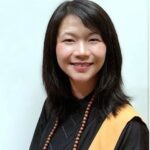Dharma Drum features the timeless drumming of the UNESCO World Heritage Site, Tongdosa Monastery, in South Korea, outside of Busan. The renunciant Tongdosa monks have performed this as a prayer for the enlightenment and liberation of all sentient beings in the three thousand multiverses for hundreds of years. This prayer is also poetically articulated as the following,
Beings are countless;
I vow to liberate us all.
Sufferings are inexhaustible;
I vow to overcome them all.
Enlightened teachings are boundless;
I vow to learn them all.
The Awakened Way is unsurpassable;
I vow to become it fully.
The ancient and rhythmic percussions seem to shake the earth beneath our feet, while the dynamic visual art continues to acknowledge the mind-numbing suffering of war and injustice, interlaced with activism for hope, peace, and equality. As expressed through the drumming and the entire installation, the determination and path for unconditional love and universal enlightenment are ancient. They are gifted to us when most of humanity eked out a subsistent existence. People back then also had no clue how to treat and prevent many contagious ailments. The world has its problems now, big problems, as it did then. It has never been perfect. Yet that did not stop our ancestors from creating and sustaining these powerfully inspiring rituals and declarations to imagine a future of universal enlightenment and work towards it with their human strength. If they could do it then, we can do it now.
Selected Screening & Awards:
- Award Winner: Samskara International Film Festival
- Award Winner: Busan New Wave Short Film Festival
- Finalist: KOREA INTERNATIONAL SHORT FILM FESTIVAL
- Finalist: Awareness Festival
Contributing Artists:

Rebecca D. Nie
Z.M. Rebecca Nie is the Buddhist Chaplain at Stanford. She is also a Stanford alum, Zen Master of the Korean Jogye Order, and an established Californian visual artist. As an heir of one of the oldest living mystic orders, she creates to artistically invite the audience into Zen encounters that are direct experiences of the transcendental. The inspiration for Z.M. Nie’s art comes from her introspection, global adventures, and attainment in diverse disciplines.

Tongdosa Monks
For hundreds of years, the renunciant monks of Tondosa Monastery have performed this as a prayer for the enlightenment and liberation of all sentient beings in the three thousand multiverses. They wake up and start the day drumming before dawn everyday, and enact this rhythmic and dynamic prayer once again every evening.
Tongdosa was established by the monk Jajang-yulsa after returning from Tang China in 646 AD,[3] during the reign of Queen Seondeok of Silla. It thrived throughout the Later Silla and Goryeo periods (918-1392), when Buddhism was the state religion, and remained strong even during Joseon.
Tongdosa is reputed to house several relics of the Buddha himself, including a robe, a begging bowl, and a bone from his skull,[3] all relics that Jajang-yulsa brought back from the travels to Tang China he undertook in 636 to study with ten other monks.